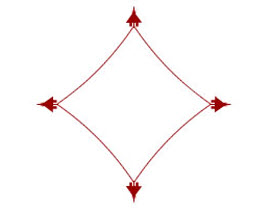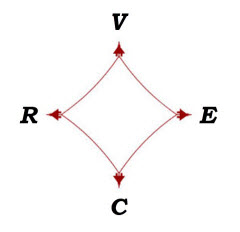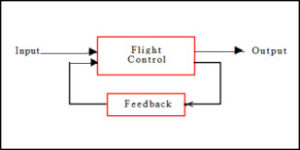Leadership Diamond©
Philosophy:

The wisdom of the ages. Philosopher Peter Koestenbaum, introduced in earlier sections, stated his life’s work has been to make philosophy accessible to others. To do so he defined the four essential dimensions of human existence—Vision, Courage, Reality, Ethics—and described how they act as strategies, individually and in combination, to achieve successful outcomes. As stated in the opening introduction, the interrelationship of the four leadership dimensions is shown by Peter in his mental model, the Leadership Diamond©,
Describing the Leadership Diamond©
Consider the diamond as a flexible membrane that represents the leadership mind. At rest it has a relaxed diamond shape: When the leadership mind is active, its strategic forces thrust outward causing the diamond to stretch to new dimensions (hence the image curvature as shown below). These forces are applied in equal strength to achieve the optimum strategic balance.
When the leadership mind is active, its strategic forces thrust outward causing the diamond to stretch to new dimensions (hence the image curvature as shown below). These forces are applied in equal strength to achieve the optimum strategic balance.
Throughout this presentation the following image is displayed visually showing the interrelationship of the four leadership strategies. Below each diamond image are brief statements appropriate to the situation at hand. This example displays Peter’s summary of each leadership dimension.

The Leadership Diamond©
Vision: to see the larger perspective
Courage: to act with sustained initiative
Reality: to have no illusions
Ethics: to serve based on principled standards
This mental model is brilliant in its simplicity and in the manner in which the individual strategies are combined to strengthen and complement one another.
In Flight, the Leadership Diamond©
When climbing into the cockpit operational issues come to the forefront. The pilot’s challenge is in the next few hours, minutes and seconds. Achieving near-term objectives is the primary mission at hand. Imagination and thoughtful action are necessary and personal leadership during flight operations is an essential proficiency.
The diamond’s strategic forces may be described as follows:
Vision: Anticipation—the pilot’s concepts of the flight ahead adapt to new information as it is received. Before and during flight the pilot forms mental images of the actions to be taken, and these images sharpen as flight parameters, terminal and enroute weather, departure and arrival conditions, etc. are obtained. The cockpit leader’s mind and senses are tuned to what lies ahead.
Courage: Confidence—challenge and sense of adventure tend to attract determined, self-assured people to flying. The cockpit leader commits to achieving mission success while demonstrating self-confidence and the ability to deal with uncertainty.
Reality: Awareness—the cockpit leader respects the aviation environment and is aware of the situations that may affect the flight, knows both aircraft and personal capabilities/limitations and continually seeks new information by interacting with others, through training/experience and by self-learning.
Ethics: Character—the cockpit leader acts with integrity based on embodied principles, shares aviation knowledge freely, and has a highly developed sense of duty to colleagues, the aviation industry and the public being served.

In Flight, the Leadership Diamond©
Vision: Anticipation
Courage: Confidence
Reality: Awareness
Ethics: Character
This diamond model provides a summary view of cockpit leadership in operational flight settings. Specific Leadership Diamond© applications are or will be employed to present and describe a wide range of flight-related situations and topics.
The Diamond’s Leadership Dimensions
Strategic Forces
The following series of posts in this section providee representative descriptions and examples of the outward cardinal forces—Vision, Courage, Reality, Ethics—that stretch the leadership mind in real time. Many characteristics are universal while others are specific to operational requirements, aircraft type and other variables.
Diamond Applications
Potential applications include every aspect of flight, includung:
Aeromedical and HF issues, Conflict resolution, CFIT and terrain avoidance, SHELL model, SMS issues, Judgment, Decision making, Airmanship, CRM, Team management, Fuel management, Situation awareness, Pilot attributes, Subscriber suggestions.
Prelude to Cockpit Leadership
Aviation Safety Proceedings
In the spring of 1993 the Seventh International Symposium on Aviation Psychology was held at The Ohio State University. Three of the presenters were from the Boston Massachusetts area, Captain Bob Mudge, representing his company Cockpit Management Resources, Inc., Norm Komich , representing Flight Safety International and myself , representing the Massachusetts Aeronautics Commission. We presented individual papers related to aviation human factors, pilot training, cockpit management and leadership.
Interestingly, we did not know one another prior to this symposium. However, over the years we became and remained good friends and stayed in regular contact.
Tributes
This website presentation would not be possible without the contributions of these fine aviation professionals. Each shared his knowledge and insights with enthusiasm and good humor.
Sadly, in recent years, both Norm and Bob have flown their last flights. Each made enormous contributions to the aviation community.
Their comments in the following posts and elsewhere are written in the present tense to acknowledge their wisdom will always be with us.
Captain Bob Mudge flew with Northeast Airlines, a company acquired by Delta Airlines in the 1960s, Bob authored a book, Adventures of a Yellowbird, documenting the unusual history of his original airline. A training captain with Delta, Bob retired and founded Cockpit Resource Management, Inc. In this capacity he developed the Quantum Management System (QMS), a pioneering CRM training program.
Bob believed in teaching a cockpit management system and believed that many CRM programs were “too subjective.” QMS is well accepted, notably in corporate aviation.
Norm Komich was a Search and Rescue helicopter pilot in Viet Nam and received the Distinguished Flying Cross. After serving as an airline First Officer, a position that gave birth to many anecdotal stories, he flew as Captain. He served both nationally and regionally on ALPA safety committees.
Norm was a natural teacher, and always had pertinent stories, humorous and practical, to make sure his points were understood. He connducted a number of CRM related workshops, including one for NASA test pilots.
It was my good fortune to spend hours with Bob in his home basement office dicscussing aviation safety. He shared, I absorbed. Norm and I became good friends and fellow Daedalians. We conducted workshops and made presentations together. Norm and Bob touched many lives in aviation and beyond and are indeed missed.
/s/ Bob Jenney

